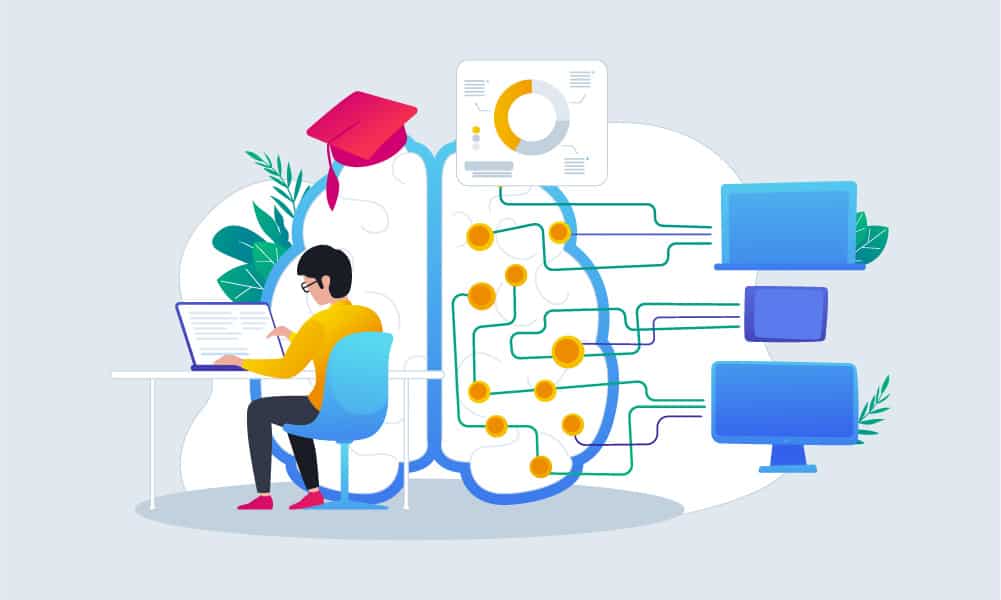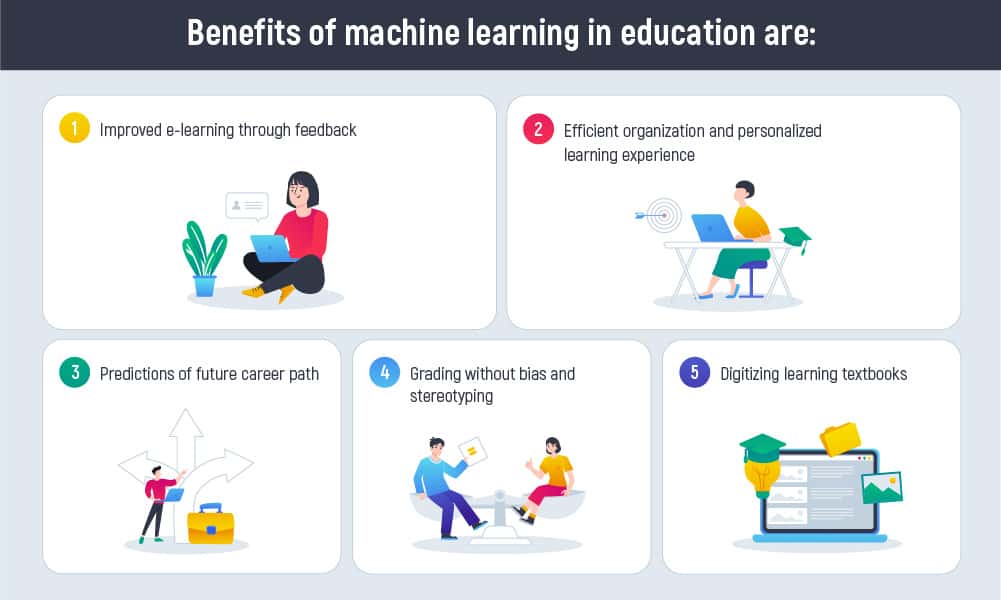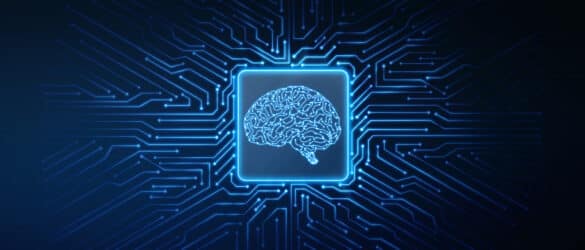Education has drastically changed over the last couple of years. Everything is functioning remotely, and it means that the ways of studying are improving learning and becoming more comfortable for students and teachers. Machine learning helps us be in no rush and manage our time correctly. Yet, we are still discovering all the possibilities machine learning offers. There are a lot of benefits of deep learning in education and machine learning that have become essential in everyday life. This article discusses the potential benefits of machine learning for education in 2022 and involves the deep benefits of machine learning in education research. Get to know why ML and AI are the future of education from different credible sources!
- Machine Learning in Education Sector
- Modern Role of Machine Learning (ML) in Education
- 5 Key Benefits of Machine Learning in Education
- Benefits of machine learning in education are:
- Improved E-learning through Feedback
- Efficient Organization and Personalized Learning Experience
- Predictions of future career paths
- Grading without bias and stereotyping
- Digitizing learning textbooks
- Benefits of machine learning in online education
- Personalized content
- Automation
- Intelligent feedback
- How We Can Help You to Apply ML for Your Educational Project
- Conclusion
Machine Learning in Education Sector
The role of machine learning in education has increased. Artificial Intelligence and Machine Learning are now ruling the industry. Of course, the reason for this is continuing remote working and the constant development of EdTech. The traditional ways of learning are now considered less efficient than it was a few years ago. Using machine learning in education helps a lot of students make their schedules flexible and causes less stress. Thanks to machine learning projects in education, the academic world has become more convenient and personalized.
Modern Role of Machine Learning (ML) in Education
One of the main benefits of machine learning in the education industry is that it is available basically for everyone. Now people are living in a world where there are a lot of challenges, so they have to be mobile and flexible according to different circumstances. The modern role of machine learning in education is hard to underestimate. Testing, individualized tutoring, coaching – everything works for improving education and making it as modernized as possible.
Here are a few examples of Machine Learning usage in the modern education system.
- Teacher Task Assistance. It’s not a secret that it is quite draining for teachers to spend hours to assist students to work. One of the advantages of machine learning in education is the automatization of the processes. The programs such as Grammarly use a combination of machine learning and human understanding. It eases the task for teachers and gives them time for self-development. It also can refer to the advantages of machine learning in higher education.
- Smarter Data. It is quite important to keep students in check, especially in today’s world full of threats. Smarter data for school operations helps monitor if students are in safety. It scans concerning keywords on school-issued devices and alerts the administrator. Sure, it also involves human consideration, as there can be different cases.
- Testing. Probably, this is one of the most essential benefits of machine learning in online education. A lot of companies nowadays provide learning, testing, and feedback to students, so it’s not just about assessment. This technology is quite helpful if a student needs to fill the gaps in knowledge or learn something completely new.
- Individualized Learning. Now students require a more deliberate approach, and Machine Learning is what makes things a lot easier. On the market, there appear more and more programs, games, and software that are adapting to the individual requirements of a student.
This way, we can see that the role of Machine Learning in education is truly significant, as the industry is growing and offering a lot of options. Your task is to use and benefit from them.
5 Key Benefits of Machine Learning in Education
Machine Learning is a part of artificial intelligence that is powered by algorithms. In other words, ML helps a machine that is given a task, to accumulate data, learn from this data and improve results within time. Using an algorithmic approach, ML can make valuable decisions and predictions that are improved with experience. Thus, ML is used in various industries to improve and enhance the smartest expectations of every sector. And the education sector is not excluded here. The global market for AI and ML in education is estimated to increase significantly up to 2023.
Benefits of machine learning in education are:
Improved E-learning through Feedback
In any online course created by educators, there is a possibility for students to leave their feedback. Personal opinions on the course excellence and material enhancement can be really helpful in managing student performance and activity. So, basically, AI and ML interpret the received feedback, learns on possible repetitions, and notifies the educator immediately. Isn’t it a perfect way to know what works in your course and what isn’t working the way it should?
Efficient Organization and Personalized Learning Experience
With the help of Artificial Intelligence (AI) and a cloud-based Learning management system (LMS), any educational process can be personalized to every student’s need. Teachers can give students tasks and monitor their understanding of concepts, test different learning approaches, and find one with the best possible learning results. The times when one learning curriculum suited every student without exception have long gone. Students are individuals with different learning perceptions and paces. Thus, ML and AI learn from the data and help in giving feedback to teachers. This allows educators to set up better e-learning practices for their students as well as organize them logically.
Predictions of future career paths
Applying machine learning in education helps in analyzing students’ performance and capabilities. To add, with the help of algorithms it is easy to understand what are the students’ strengths and weaknesses. For example, let’s take a college student application and analyze performance, teacher feedback, and best results. This way, the student will become aware of what he’s/she’s great in and what’s not. Thus, AI and ML will process student progress and suggest the most effective career path based on the level of subject completion. And, that might be a successful insight for a future career choice.
Grading without bias and stereotyping
Sometimes, at schools teachers practice grading students based on their mood, personal preferences, prejudices, and non-common logic. For this reason, the benefit of ML/AI is in the inability of a machine to be biased and stereotype students. With no specific attitudes, students can get a clear picture of how they are proceeding in their studies. Here, ML and AI will not just process all the grade-related data, but also suggest grades for students. If the teacher isn’t going to be involved, this will add to student equality.
Digitizing learning textbooks
With the help of AI and ML, paperback textbooks can be transformed into online sources like digital books, videos, forums, and scientific articles. What’s more, the algorithm may show you similar results based on the topic you’re studying or the material you are trying to find. It is quite handy when there’re numerous sources and ML/AI gives you the list of the most specific ones you need. This benefit is especially convenient in e-learning environments, where the teacher gives only the task and the research falls on the student’s shoulders.
Nowadays more and more schools, colleges and universities try to adjust to the technological part of studies. David Greene, a president of Colby College, which is implementing AI and ML technologies into its curriculum, has shared some of his thoughts about ML and AI improving the process of education:
… in future it is absolutely ubiquitous in higher education, because of the way that it is shaping all of our interactions, whether we’re online or the way that we’re gathering information today, or the way that companies are actually marketing to us on a daily basis. If you’re an English scholar, or you’re in sociology, you’re interested in immigration patterns around the world, you’re probably going to be using machine learning to really look at those in a deep way. If you’re interested in being able to look at the textual analysis across millions of volumes, you’re going to need machine learning to be able to do that. And I think it’s important for us to get out ahead of this because in 10 years if you are not in AI in a big way, for most colleges and universities it’s going to be very hard to be relevant.
So, in 10 years ML and AI will be inseparable from education and it will be hard for those, who are not taking small steps in this direction. But, the ones, who understand the potential benefits in education are IBM Corporation (US), Microsoft Corporation (US), Google (US), Amazon.com, Inc., (US), Cognizant (US), Pearson (UK), Bridge-U (UK), DreamBox Learning (US), Fishtree (US), Jellynote (France), Jenzabar, Inc., (US).
Expand your knowledge on the topic, learn more about machine learning outsourcing!
Benefits of machine learning in online education
Online education requires skills and specific tools to help students do their work. Machine learning eases people’s lives and brings new possibilities. You can accomplish your goal step by step with the help of use cases and tips; the machine can be evaluating experience of yours and testing your knowledge; media content is really helpful if you are a visual learner. Let’s check out some main benefits of machine learning in online education.
Personalized content
This is quite useful if the student requires deliberate approach. If the person struggles with some task, the system will spot it and choose the best options to teach this particular student. If you want some additional information, the programs can always provide you with it. If something is too difficult for you, you can choose your own pace and study comfortably.
Automation
This is relevant especially for teachers. Sometimes the time one could spent on self-development gets wasted on boring paperwork that requires lots of attention. With Artificial Intelligence this problem disappears: while the teacher comes up with fresh exciting ideas for classes, the program does all the busywork with the help of automation.
Intelligent feedback
If the student needs to know his strengths and weaknesses, the feedback Machine Learning provides is usually objective and precise. If you have any questions, the AI is ready to evaluate you, give you advice and choose the best learning options for you specifically.
Online education is becoming more common, and along with our skills, Machine Learning is developing every day. There is no doubt that in the future positions of AI in the education world will only become stronger.
How We Can Help You to Apply ML for Your Educational Project
If you are interested in creating your educational project, Inoxoft will become the perfect partner for edtech software development. We provide the best machine learning development services for our clients all around the world and our task is to meet our customers’ business needs. By choosing us, you can be guaranteed safety and devotion from our team!
Inoxoft provides information on machine learning in fintech and artificial intelligence in web development. If you generally want to know more about Machine Learning, you can read our article on the startup’s utility box.
Diving into Machine Learning can be easy, even if you are a newcomer. Contact us and begin your journey with Artificial Intelligence!
Conclusion
To conclude, machine learning in the education sector is one of the most needed technologies to be implemented. With the help of artificial intelligence and machine learning, education can transform to a new level, where:
- the grading system is fair and transparent
- teachers understand what has to be taught and how
- teachers know what methods work for each particular student
- courses are flexible and can predict the students’ career path
- sources are uploaded and offered based on the researched topic
The benefits are extensive and in 10 years from now, every institution or business ignoring ML implementation will fall behind. Don’t be among them, implement machine learning in your education course platform, or business idea today. Choose our machine learning services to succeed.
Frequently Asked Questions
What is the application of machine learning in education?
There are a lot of applications, such as QuizLet, Grammarly, SchooLinks, MobyMax, Duolingo. If you want to know more about applications of machine learning in education, scroll up!
What are the advantages of machine learning in education sector?
Machine learning lets you organize your time, makes the studying more exciting and offers a lot of possibilities. In this article you can read about all the benefits of machine learning in education.
How does machine learning help in schools?
Not only it allows to keep students in check. but also takes less time for teacher to assess works. Machine learning is an essential thing in the world of remote learning.










